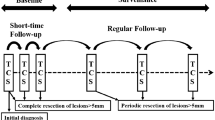Abstract.
The justification of colectomy and ileorectal anastomosis as the primary treatment for familial adenomatous polyposis (FAP) remains questionable because of the rectal cancer risk. We estimated both the cancer risk and the need of rectal excision for benign polyposis in 100 FAP patients. We also evaluated the effects of sulindac therapy and the complications of polyp fulgurations during the follow-up time of the median of 10.6 years (2 to 29 years) after ileorectal anastomosis. There were 46 women and 54 men with a mean age of 32 years (17–67 years) at the operation. Forty-two patients were propositi and 15 had colon cancer primarily. Cumulative risk of rectal cancer and combined risk of cancer and rectal excision for other causes were estimated (Kaplan-Meier analysis) both from the date of surgery and from birth. Nine patients developed rectal cancer, while 12 others has the rectum excised for benign conditions. The cumulative rectal cancer risk was 4%, 5.6%, 7.9% and 25% at 5, 10, 15 and 20 years after the operation, respectively. Rectal excision rates were 7.3%, 13.7%, 23.6%, and 36.6%, correspondingly and finally 73.8%. Age-dependent rectal cancer risks were 3.9%, 12.8% and 25.7% at 40, 50 and 60 years, and the rectal excision rates 9.5%, 26.3% and 44%, respectively. Sulindac caused at least partial regression of rectal adenomas in 71% of patients without major adverse effects, but the long term effects of sulindac and impact on malignant transformation of rectal adenomas are not known. Our results favour proctocolectomy and ileonal anastomosis as the primary operation for FAP instead of colectomy and ileorectal anastomosis.
Résumé.
La justification d'une colectomie avec anastomose iléo-rectale comme constituant le traitement primaire d'une polypose adénomateuse familiale reste très controversée en raison du seul risque de cancer rectal. Nous avons tenté de définir à la fois le risque de cancer et la nécessité d'une excision rectale pour des polypes bénins chez 100 patients porteurs de FAP. Nous avons également évalué l'effet d'un traitement au sulindac et les complications de l'électrocoagulation de polypes durant la période suivie qui est en moyenne de 10,6 ans (2 à 29 ans) après une anastomose iléo-rectale. Quarante-six hommes et 54 femmes avec un âge moyen de 32 ans (17–67 ans) ont été opérés. Quarante-deux patients étaient porteurs d'une pré-cancérose et 15 avaient un cancer colique certain. Le risque comulé de cancer du rectum et le risque combiné d'un cancer et d'une excision rectale pour d'autres causes ont été estimés (analyse selon Kaplan-Meier) à la fois à partir de la date d'intervention chirurgicale et à partir de la naissance. Neuf patients ont développé un cancer du rectum alors que 12 ont eu leur rectum excisé pour les lésions bénignes. Le risque cumulatif des cancers du rectum est de 4%, 5,6%, 7,9% et 25% à 5, 10, 15 et 20 ans de l'opération respectivement. Les taux d'excision rectale sont de 7,3%, 13,7%, 23,6% et 36,6%. Le risque d'un cancer du rectum on fonction de l'âge est de 3,9%, 12,8%, 25,7% à 40, 50 et 60 ans et le taux d'excision du rectum respectivement de 9,5%, 26,3% et 44%. Le sulindac entraîne au moins une régression partielle des adénomes du rectum dans 71% des cas, sans effet secondaire majeur mais les résultats à long terme du sulindac et les répercussions sur l'éventuelle transformation maligne des adénomes du rectum ne sont pas connues. Nos résultats sont en faveur d'une proctocolectomie et d'une anastomose iléo-anale comme traitement de choix de première intention en cas de FAP à la place de la colectomie avec anastomose iléo-rectale.
Similar content being viewed by others
Author information
Authors and Affiliations
Additional information
Accepted: 17 December 1996
Rights and permissions
About this article
Cite this article
Heiskanen, I., Järvinen, H. Fate of the rectal stump after colectomy and ileorectal anastomosis for familial adenomatous polyposis. Int J Colorect Dis 12, 9–13 (1997). https://doi.org/10.1007/s003840050070
Issue Date:
DOI: https://doi.org/10.1007/s003840050070




